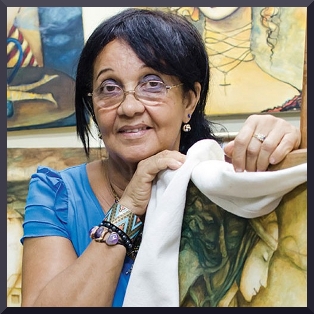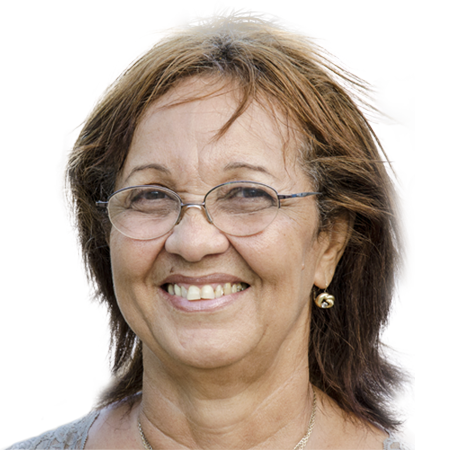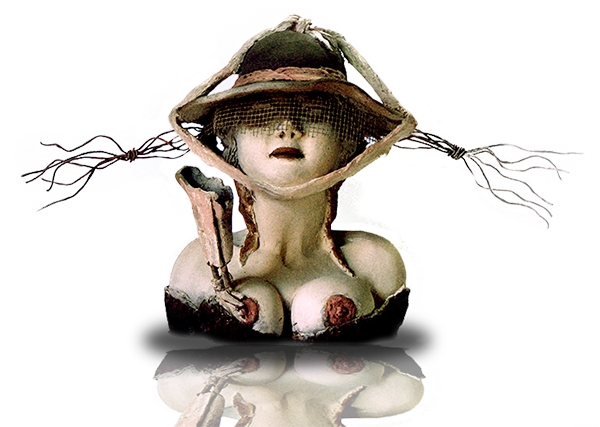

Martha Jimenez: "Camaguey is for me inspiration and oxygen"
Martha Jimenez is an acute observer, perhaps for that reason her work possesses such a high dose of realism, in its case, gripped by a particular poetic interweaving.
Her way of working could be divided into two great moments: one conceptual and another about customs. As she revealed to OnCuba, there was a period of her life when she did not have room to create because "my role as a mother monopolized me all the time". Just at that moment begin to appear characters fabled from her immediate surroundings.
Another singularity of the work of this creative is that she investigates in psychological aspects of each one of the personages that represents, while -consciously- she shows contradictory features and traps daily events and reactions. It is also interesting to capture gestures of the idiosyncrasy of the Cuban that makes explicit so that "the viewer is reflected in the work, and feels part of it". The feminine theme is a constant in her work. She assures that she does not align herself with any feminist movement, but she is interested in "incarnating women within her world as a decisive social entity that has solid values". The Cubans, she says, "have won conquests ... and still lack: we have to value ourselves in our right dimension, to dream, to impose goals and, above all, to fulfill them". Her voluptuous women, with huge hips and fleshy lips -without any influence of the Colombian Fernando Botero- they reaffirm that, on the one hand, they are the support of the Cuban family, as well as expressing how much we owe to Africa. There are also slender ones, with fine commissure and aquiline noses, that refer to that part of the Caribbean of marked French influence.
Although she has been involved in different specialties within the visual arts, Martha favors pottery, a manifestation that, at times, has been described unfortunately as "the Cinderella of the visual arts". There are two people, she says, who should be thanked for the vindication of pottery: "Amelia Pelaez did an impressive work in enamelled ceramics, and Alejandro G. Alonso, director of the National Museum of Cuban Contemporary Artistic Ceramics, carries out an systematic and commendable work". Equally, she emphasizes, with his work and results, the teacher Alfredo Sosabravo that has "elevated the Cuban pottery", providing characteristics and distinctive features.
Martha was not born in Camaguey, where she has developed her work and built her family. But, it seems that she was predestined to that place because, historically, in Puerto Principe -third villa founded in Cuba by the Spaniards on February 2, 1514- there has been a deep pottery tradition ranging from the making of clay tiles -to house large palaces, churches and the most humble homes- to the emblematic tinajon (jar), symbol of the city. "I like to imagine that Camaguey is an immense kiln". And that passion for "the burning", essential for the ceramist, contains many secrets: "Opening the oven door is always a magic act because you face surprises that can fill you with joy or disappoint you. Inside the furnace chemical processes occur and even accidents that result in a better piece -it has happened to me- but I have also seen with irremediable pain the fragmentation of others".
For her, modeling, creating shapes with her hands -that can be taken to the terracotta or other support, such as bronze- constitutes one of her greatest enjoyments. The tridimensionality traps her and acquires a weight in her pictorial work: "when model -I am referring to the mud- I do not make drawings, I do not make sketches but I go directly to the creation, and it is how I work better. I also love engraving because of the high level of experimentation it presupposes and the possibility of working with textures".
Brush with soul of kiss is the community project -dedicated to children and young people- that has allowed her to feel "complete", because for this creative the pedagogy has been a vote that began more than thirty years ago and she has not abandoned, although she accepts that "teaching steals a lot of time". It is important for her to "train the new generations. I do not mean only that they learn to paint but to the fact that the visual arts help the human being to outline his behavior and contribute to his psychic-mental development. It is imperative to be aware of how important art is, and, from children, to impart knowledge so that in adult life are women and men with spirituality and values".
About four years ago Martha participated in the V International Symposium of Sculpture held in Turkey and won the only prize awarded by the event with a work entitled "The Rider" (1,90 meters high), and in Istanbul she left the piece "The fourth part of the human body" (2,90 meters high). For the artist, "the most relevant of that experience was the possibility of working in large dimensions", something that was happening for the first and only time.
Camaguey owns the imprint of Martha Jimenez, thanks to several pieces and sculptural sets arranged there. Among the most longed for the artist is to perform a piece of more than 3 meters. It would be, he says, a gift for Camaguey that is for me "inspiration and oxygen".
The sculptress, painter, draftsman, engraver and ceramist Martha Jimenez, is among the creators who emerged in the first graduation of the School of Art Instructors, in 1971. From then on, she has developed an intense career recognized on multiple occasions. She won a prize at the Second International Biennial of Teapot Contemporary Art in Shanghai, China, and in 1997 she was awarded the Prize of the Union of Writers and Artists of Cuba, UNEAC, and since 1997 she holds the UNESCO Prize for Best Works; in 2005 she was awarded the UNEAC Prize, awarded by the Union of Writers and Artists of Cuba, for her Sculpture Project Plaza del Carmen, located in the emblematic site of the once Villa de Santa Maria del Puerto del Príncipe, now Camaguey.
Her works are in private collections in Germany, Argentina, Belgium, Canada, Colombia, Chile, China, Spain, the United States, France, Greece, Italy, Mexico, Peru, Dominican Republic, Sweden, and also in institutions such as the Museum of Colonial Art, Contemporary Artistic Ceramics and in the Collection of Art of Our America, Casa de las Americas in Havana; in the Madison City Hall Museum Collection in the United States; the Arts Museum at the Art and Craft Villa in Paris and the Museum of Fine Arts in Montreal, Canada, among others.
Author: Estrella Diaz
Source: On Cuba Magazine




